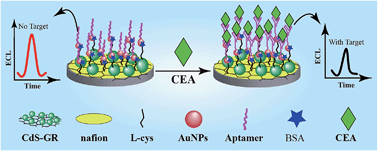Aptasensor based on tripetalous cadmium sulfide-graphene electrochemiluminescence for the detection of carcinoembryonic antigen
Abstract
A facile label-free electrochemiluminescence (ECL) aptasensor, based on the ECL of cadmium sulfide–graphene (CdS–GR) nanocomposites with peroxydisulfate as the coreactant, was designed for the detection of carcinoembryonic antigen (CEA). Tripetalous CdS–GR nanocomposites were synthesized through a simple onepot solvothermal method and immobilized on the glassy carbon electrode surface. L-Cystine (L-cys) could largely promote the electron transfer and enhance the ECL intensity. Gold nanoparticles (AuNPs) were assembled onto the L-cys film modified electrode for aptamer immobilization and ECL signal amplification. The aptamer modified with thiol was adsorbed onto the surface of the AuNPs through a Au–S bond. Upon hybridization of the aptamer with the target protein, the sequence could conjugate CEA to form a Y architecture. With CEA as a model analyte, the decreased ECL intensity is proportional to the CEA concentration in the range of 0.01–10.0 ng mL−1 with a detection limit of 3.8 pg mL−1 (S/N = 3). The prepared aptasensor was applied to the determination of CEA in human serum samples. The recoveries of CEA in the human serum samples were between 85.0% and 109.5%, and the RSD values were no more than 3.4%.


 Please wait while we load your content...
Please wait while we load your content...